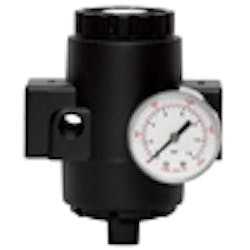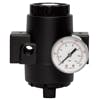Reverse flow regulators
Reverse flow regulators provide regulated pressure control from into-out and quick exhausting from out-to-in. When pressure on the inlet side is exhausted, the regulator piston or diaphragm snaps open to allow immediate exhausting of secondary pressure. Come in stackable or non-stackable units and are suitable for dual pressure control of cylinders or other pneumatic actuators. Stackable reverse flow regulators have ¾-in. supply ports and ½-in. outlets. A gauge is included, and maximum flow capacity is 90 scfm over a 0 to 100-psig regulated pressure range.
Ross Controls, (800) 438-7677,
www.rosscontrols.com


